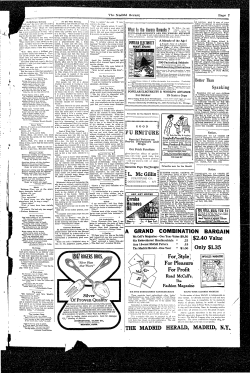
John Scruton
Trademark Protection Under the Madrid Protocol: Strategic Considerations Presented by John Scruton Advantages of the Madrid Protocol • Ease of Application • May Reduce Costs • Centralized Maintenance Disadvantages of the Madrid Protocol • IR is tied to the Basic Application – Limits on description – Subject to “central attack” • May be more expensive Advantage: Ease of Application • Single filing with US Patent and Trademark Office • Filing in one language – English works • Potential to extend protection to 91 countries Ease of Application • Efficiently secure priority in a large number of countries – Importance of priority • Efficiently obtain protection in a large number of countries – Registration more important abroad Ease of Use • Not necessary to engage local counsel – But sometimes a good idea anyway • Searching • Prosecution • Centralized location for – Renewals – Address and name changes – Recording assignments and licenses Advantage: Flexibility • Ability to later designate additional countries for protection • Ability to assign rights for individual countries – Compare CTM – all or nothing Disadvantage: Limitations • Limited to Basic Application/Registration • Mark must be the same – No separate marks for different markets • Description of goods and services may not exceed the basic application/registration – U.S. system is more restrictive than abroad A Foreign Registration A Foreign Registration, cont’d A Foreign Registration, cont’d Disadvantages: Central Attack • IR is tied to the success of the Basic Application/Registration – Basic application may never become registered for a U.S.-specific reason – Basic registration may be cancelled for a U.S.-specific reason • Likelihood of confusion with mark used only in U.S. • Other technical reasons, e.g. disparagement (is REDSKINS considered disparaging abroad?) Limitations on Disadvantages • IR stands on its own after 5 years • Failed IR may be converted to National Applications and retain IR’s priority –Additional unplanned expense Disadvantages • No ability to amend the mark • New countries added after registration are on the IR’s timeline –Does not enjoy a full 10-year term Strategic Considerations • Goal: Broadest Possible Rights • U.S. companies may want to consider alternatives – Applications not limited to U.S. description of goods allow broader protection – Potentially use another country for basic application • National of, domiciled in, or “real and effective industrial or commercial establishment” in another Madrid country? Goal: Limit Costs • Madrid advantages: –Simplified initial application –Simplified renewals and maintenance • Searching and prosecution costs similar to national applications Madrid Filing Costs • Fees vary widely between member countries • Structure of fee (all fees are in Swiss francs): – Basic filing fee: 653 – Basic supplementary fee for classes beyond 3: 100 – Basic complementary fee for each designated country: 100 – Madrid Protocol countries may have individual fees that vary country to country • Fee calculator at: www.wipo.int/madrid/en/fees/calculator.jsp A Sampling of Individual Fees • • • • • • • • • Belarus: 600 + 50/class beyond 3 classes China: 249 + 125/class beyond 1 class Cuba: 2-part filing fee 274 + 82, + 91/class past 3 EU: 1,111 + 192/class beyond 3 UK: 262 + 73/class beyond 1 India: 51 + 51/class beyond 1 Japan: 2-part fee 99 + 328, + 75/class beyond 1 Oman: 484 + 484/class beyond 1 San Marino: 178 + 47/class beyond 3 Fees in the Stans • Tajikistan: 420 + 16/class beyond 1 • Turkmenistan: 178 + 90/class beyond 1 • Uzbekistan: 1,028 + 103/class beyond 1 Goal: Broadest Geographic Coverage • Madrid is good but may require supplementation • 91 countries under the Madrid Protocol – Albania to Zambia Madrid Map Non-Signatories • • • • • • • • Argentina Brazil Canada Indonesia Malaysia Pakistan South Africa Many others in South America and Africa Goal: Maximum Protection Against Third Party Claims to the Mark • Madrid allows quick and efficient filing in much of the world • Priority as of ITU filing date Goal: Flexibility • Madrid does not allow changes to the mark – U.S. allows minimal changes that do not alter the commercial impression • No different marks in different countries • Madrid limits assignment to those in Madrid countries • Madrid allows assignments of rights in less than all countries – CTM is a unitary system: no piecemeal assignment Licensing • Some may require recording of licenses – Madrid allows central recording • Recording of “registered users” in some so that use by licensee inures to licensor • Government approval of licensees may be required Office of Origin • Flexibility where applicant has operations in multiple Madrid countries • Consider for breadth of description • Consider for strength of application or existing registration – Avoiding central attack Madrid and CTM • Failed CTM application may be converted to national applications • Failed Madrid application designating EC may be converted to CTM – Opportunity to address issues that led to refusal by limiting CTM application – If converted CTM application fails, may still convert to national applications • Cost: CTM basic fee €900 + €150 per class > 3 Other Issues • Registrability may vary in member countries – Distinctiveness may be harder to show – National examination • Use may be required – Required for registration in U.S. – Non-use may be grounds for cancellation in other countries John Scruton Stites & Harbison PLLC 502-681-0320 jscruton@stites.com www.stites.com Thanks to Garfield Goodrum Georgia Tennessee • Atlanta • Blue Ridge • Franklin • Nashville • Memphis Indiana Virginia • Jeffersonville • Alexandria Kentucky • • • • Covington Frankfort Lexington Louisville
© Copyright 2025



















